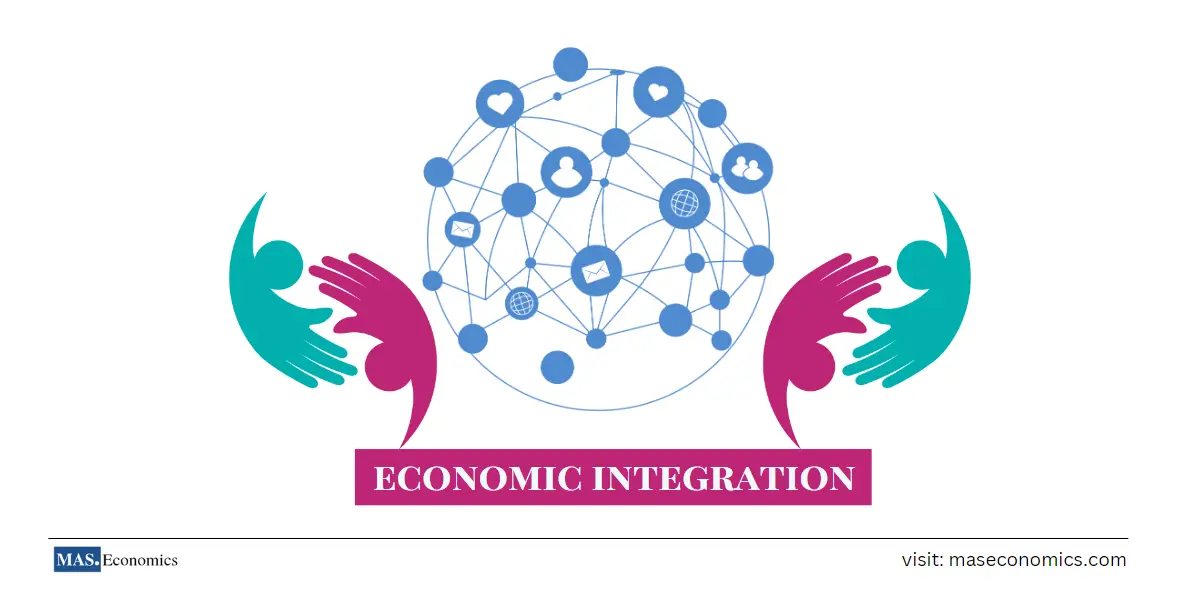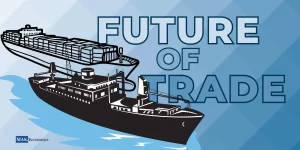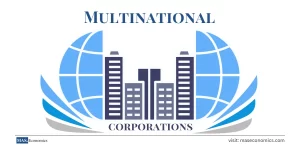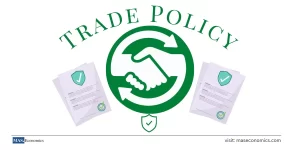Economic integration is the process of reducing barriers to trade and promoting economic cooperation among countries. It can take various forms, including FTA, customs unions, common markets, and economic unions, depending on the level of economic integration between member countries. Economic integration can be achieved through trade agreements, trade blocs, and regional integration organizations.
Economic integration is one of the key drivers of globalization, as it promotes economic cooperation and increases economic interdependence among countries.
This blog post will explore the different forms of economic integration and their potential benefits and drawbacks. We will also discuss the effects of trade creation and trade diversion on participating countries and the global economy.
Before we explain the different forms of economic integration
Let us first define…
What are Trade Agreements
Trade agreements are legally binding documents that seek to reduce barriers between countries and promote economic cooperation. They come in different forms, depending on the level of economic integration between respective countries, and involve stakeholders such as governments, businesses, unions, and other parties. These agreements cover a range of topics related to trade, including tariffs, non-tariff barriers, technical obstacles to trade, intellectual property protection, and services.
Now, it will be easy to understand different forms of economic integration and their potential benefits and drawbacks.
Preferential Trade Arrangements
Preferential trade arrangements (PTAs) are a type of economic integration involving lowering or removing tariffs on certain goods and services between two or more nations. These PTAs come in different shapes, including free trade agreements, customs unions, and common markets.
PTAs can create trade boundaries between member states and those outside the agreement, negatively affecting global trade and growth. On the other hand, PTAs may promote economic cooperation by facilitating the exchange of goods and services between participating countries. They might also include provisions for the liberalization of services, intellectual property protection, and dispute resolution.
Free Trade Area
Free trade areas (FTA) are regions where member countries eliminate tariffs on specific goods and services, allowing them to flow between countries without restrictions freely.
An example is North American Free Trade Agreement (NAFTA), which was implemented in 1994. This agreement removed tariffs on most goods and services traded between the three member countries, making it easier for businesses to operate across borders.
However, each country may maintain trade policies and regulations regarding products outside the FTA.
Customs Union
It is a group of countries that work together to reduce the cost of trading goods and services between them. This is done by eliminating tariffs and other obstacles to trade so that the countries in the union can buy and sell goods without having to worry about high taxes or extra fees.
The member countries also agree on a standard external tariff, which means they all have the same rate for imported goods from non-member countries. This helps protect the domestic industries in each country, as they do not have to compete with cheaper products from other places.
An example of a customs union is the European Union (EU), which consists of 27 countries that have removed trade barriers amongst themselves and introduced a standard external tariff on imports from other countries. This allows EU countries to cooperate economically, increase trade with one another, and protect their domestic industries from foreign competition.
The Andean Community of Nations is another example of a customs union formed in 1969 with four countries in South America to reduce barriers to trading among them and increase economic cooperation.
Common Market
A typical market is an agreement between countries that eliminate taxes and fees on goods, services, money, and people moving across borders. This makes it easier for businesses to buy and sell goods, services, and money without extra fees and allows people to move around more easily.
Examples of common markets are the European Union (EU), which has 27 countries that have removed trade barriers between themselves, and Southern African Development Community (SADC) Common Market in Southern Africa with 15 member countries.
This helps promote economic cooperation between nations and facilitates businesses and the movement of people across borders.
Economic Union
An economic union is an agreement between countries that eliminates the need to pay fees or taxes when trading goods and services, using a single currency, and having one central authority making economic decisions for the entire region. This allows goods and services to be exchanged without restrictions, businesses to be established more efficiently, and people to move around more freely across borders.
The European Union is one example, as it has 27 member states working together with a common currency (the Euro) and a policy-making body (the European Central Bank). This helps increase cooperation between nations, reduces costs for businesses and people, and creates a more robust economy in the entire region.
Another example of an economic union is the ECOWAS, or Economic Community of West African States, made up of 15 countries in West Africa. They have come together to eliminate taxes on goods and services exchanged between them, to use the Eco as a common currency, and set up the ECOWAS Bank for Investment and Development to make economic decisions for the entire region.
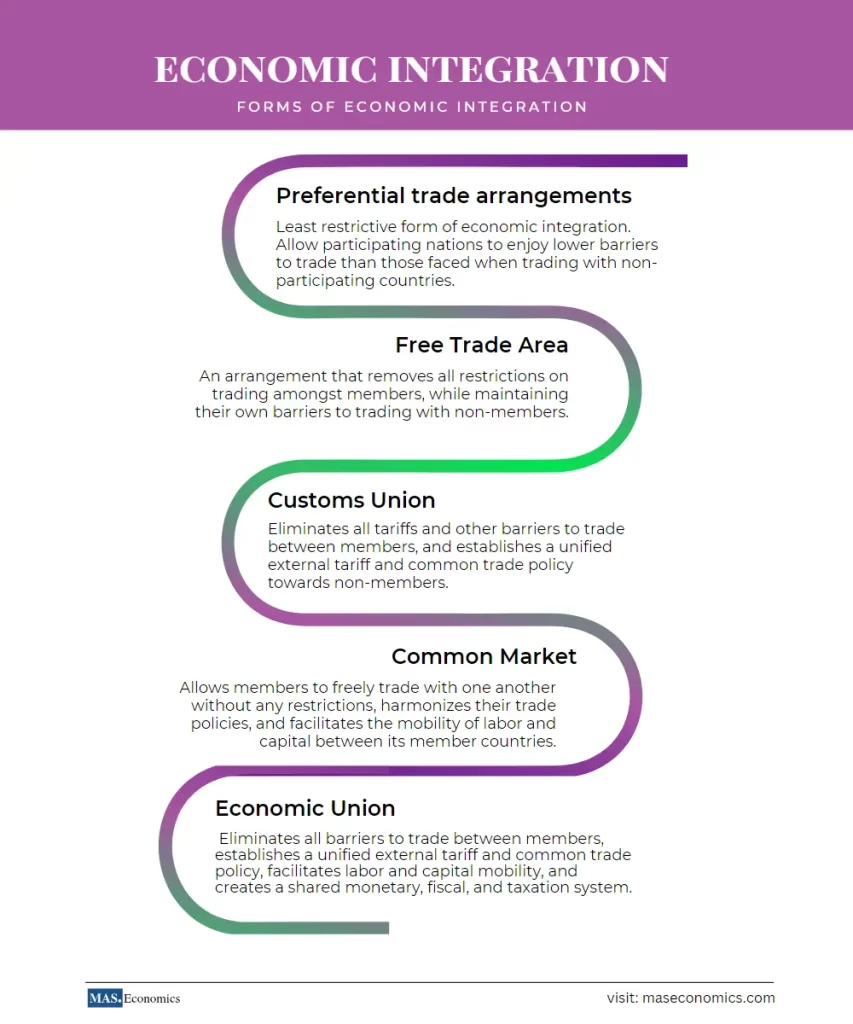
Trade creation Vs. Trade diversion
Trade agreements, such as accessible trade areas, customs unions, and economic unions, can positively and negatively affect different countries. When countries reduce or eliminate tariffs and other trade barriers, it leads to an increase in the trade called ‘trade creation.’ This can result in lower consumer prices, more economic growth, and increased competition between countries.
On the other hand, when countries give preferential treatment to their trading partners under a trade agreement, it is known as ‘trade diversion,’ which decreases trade with non-member countries. This means that there can be winners and losers within the trading bloc, depending on the type of agreement.
Free Economic Zones
FEZs, or Free Economic Zones, are specific regions in a country where businesses can get tax breaks, fewer regulations, and better access to resources. This makes it more attractive to foreign investors who can come in and create new jobs and help the local economy grow.
These zones may be focused on specific industries like exports, so companies can benefit from reduced taxes or exemptions of certain taxes when they trade with other countries. FEZs come in different shapes and sizes – from industrial parks to special economic zones – located in cities and rural areas.
This can potentially lead to more significant foreign investment, job creation, and economic growth in participating countries. However, there may be unequal results between countries, with some gaining more than others and the potential for jobs and industries to move to locations with weaker labor and environmental regulations.
Some examples of this include:
Governments worldwide have established Free Economic Zones (FEZs) to attract foreign investment and promote economic growth. Examples of this include:
- The Shanghai Free Trade Zone in China was created in 2013 to encourage foreign investment and economic growth in the Shanghai area.
- Established in 2006, Dubai World Central, located in the UAE, is a free economic zone providing logistics support and development opportunities to promote economic growth and diversification in Dubai.
- In 2018, the Gwadar Free Zone was established in Gwadar, Pakistan, to foster economic growth and foreign investment in the region.
These areas offer specific incentives like tax breaks and less regulation to businesses that invest there, which helps create jobs, stimulate economic development, and expand trade.
Free Economic Zones Vs. Special Economic Zones
Free economic zones (FEZs) and special economic zones (SEZs) are places where governments offer certain advantages, such as tax benefits and fewer regulations, to foreign businesses to invest in the area and help the local economy grow.
Though both FEZs and SEZs have this goal in mind, there may be differences between them in terms of their objectives, areas covered, and incentives given.
- FEZs are designed to boost economic growth and investment from the outside, while SEZs may focus on additional objectives like promoting exports, drawing in tech industries, and developing individual industries.
- This can be found in both towns and cities, targeting specific industries. At the same time, SEZs are mainly centered around cities, with some either concentrating on specific sectors or taking a more wide-ranging approach to economic growth.
- FEZs and SEZs generally provide similar economic benefits like tax exemptions, fewer regulations, and infrastructure access. SEZs could also include additional incentives like tax relief, customs duties waivers, and access to government support or grants.
Here are some other essential terms in economic integration
Trade Bloc
Countries form trade blocs to facilitate increased economic integration and mutual benefits, ranging from free trade areas to economic unions. They are intended to boost cooperation, trade, investment levels, job creation, and lower prices for consumers. However, trade blocs can come with some risks, such as the potential relocation of jobs from higher-standard nations to ones with lower labor and environmental protections.
Regional Integration
Regional integration is the process of economic cooperation among countries in a particular region. This can involve forms of economic integration such as accessible trade areas, customs unions, common markets, and economic unions. The primary aim of regional integration is to boost trade and investment, increase job creation, and provide lower prices for consumers. It can also lead to negative consequences, displacing jobs and businesses in countries with lesser labor and environmental standards.

